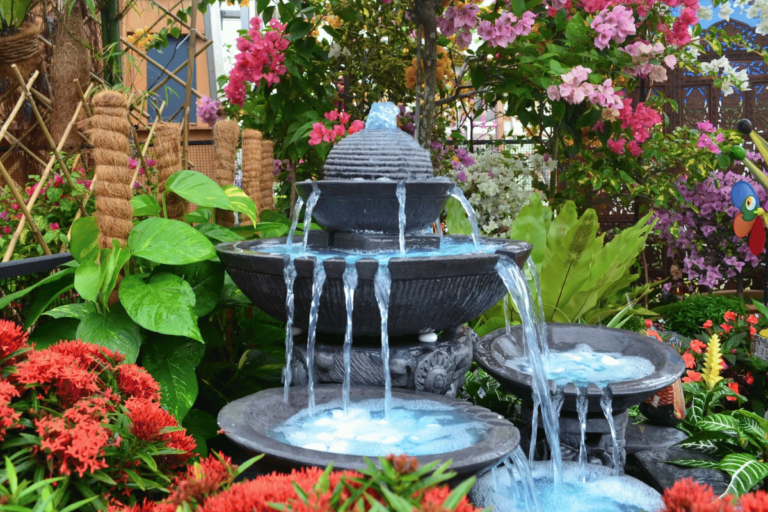Benefits of Water Features
Adding water features to your garden can boost its attractiveness, create a relaxing environment, and encourage wildlife. Examples of water features consist of fountains, ponds, and waterfalls, which are aesthetically pleasing and form focal points for the eyes. They also produce the calming sound of running water that helps reduce stress and promote relaxation.
Attracting Wildlife: Wildlife-friendly areas such as birds, frogs, or dragonflies can be attracted to your garden by an essential source such as water. These beneficial creatures help to pollinate plants and offer pest control services while at the same time adding diversity to ecosystems. A well-planned water feature may support local wildlife, creating a healthy forest you would like to have.
Example: Birds sometimes eat insects, thus reducing their populations, whereas some frogs and dragonflies prey on mosquitoes.
Improving Microclimate: Water features can enhance your garden’s microclimate by increasing humidity and cooling the surrounding areas, making it more conducive for plant growth. It is essential in hot, dry climates.
Example: Having a pond nearby will moderate the temperature in this area, making it attractive for aquaphiles.
Types of Water Features
You can choose from different water features depending on what you want to achieve with your garden. Fountains, ponds, falls, and bird baths are among them.
Fountains: You can choose fountains with highly versatile designs and various styles in different sizes using different materials. They stand alone independently but may also emerge from other landscape design elements. Fountains provide calm sounds associated with flowing waters and create focal points within a landscape. They require very little maintenance since they can be solar-powered or electrically operated.
Example: A formal garden demands a stone fountain standing on several tiers, acting as an eye-catching focus point.
Ponds: Ponds are naturalistic water features that provide habitats for aquatic plants and wildlife. These may be small, decorative ponds or more extensive, complex ecosystems. You can create a pond with fish like carp and goldfish, water lilies, lotuses, and other aquatic plants. However, maintenance is usually high, except it adds richness to your garden.
Example: A pond mix of fish and plants helps maintain an ecological balance.
Waterfalls: Waterfalls are dramatic features with flowing waters falling down rocks or other materials that might be integrated into ponds or can stand alone. Waterfalls in gardens make them more lively and active through sound and movement. Your waterfall designs solely depend on your kind of garden, whether made from stone or not.
Example: A pool fed by a cascade creates an environment close to nature but gives the impression of serenity.
Birdbaths: Birdbaths are minimalistic yet practical water features for birds and small animals where they drink, bathe, etc. Some bird baths have complex designs, while others are simple pedestals with a basin on top; they all serve the same purpose. They do not require much effort during installation; hence, any garden owner can easily install them in their backyards.
Example: A ceramic birdbath will make a great addition to any flowerbed in terms of usefulness and beauty.
Design & Maintenance Tips
The key things to consider when integrating water features into your garden include the overall design plan, the size of the area available, and maintenance needs. It is essential to correctly install and maintain water features to avoid leakage problems associated with stagnant water bodies full of algae during dry seasons.
Design Considerations:
Placement: Position water features that can be seen quickly and enjoyed, such as near seating arrangements or along garden walks.
Scale: Select the scale of your garden that matches the water feature. Small fountains may not be noticed in large areas, while ponds and waterfalls fit only in big spaces.
Integration: Blend your garden landscape with its water features using plants, rocks, and other natural materials.
Maintenance Tips:
Regular Cleaning: Remove debris frequently from your water features to avoid algae.
Water Quality: Keep up with water quality using pumps, filters, and beneficial bacteria treatments.
Winter Care: Prevent winter damage in colder regions due to freezing temperatures by properly winterizing water features.
The right choice of a water feature integrated well into your garden will help create an attractive and serene outdoor space that adds beauty and functionality to your landscape.
Explore More Gardening Tips and Ideas
- Growing Bonsai: Tips for Miniature Tree Enthusiasts
- Buying Bonsai: Tips for Selecting Your Perfect Tree
- Bonsai Potting: Essential Tips for Tree Care Success
- Bonsai Maintenance: Essential Care for Tiny Trees
- Mastering the Art of Shaping Bonsai: A Beginner’s Guide
Source: Water Features Integration In Your Garden


